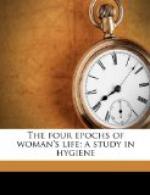Menstruation.— The etiology of menstruation has been variously explained at different epochs. The chief theories have been that of plethora, and the ovulation, the tubal, and the nerve theories.
First, the Theory of Plethora.— From the time of Hippocrates to 1835 the theory prevailed that in the female body the formation of blood is sufficiently rich to provide every four weeks for an overflow of the same, the evacuation of which becomes a necessity. It was believed that this excess of blood depended on an excess of formative power in the woman.
Second, the Ovulation Theory.— This was distinctly formulated about 1845. It construed the menstrual hemorrhage as a subsidiary phenomenon, entirely dependent on the periodic dehiscence of ovules. The changes supposed to take place in the Graafian follicles at each menstrual period were believed to involve a peculiar expenditure of nerve force, which was so much dead loss to the individual life of the woman. The growth of the Graafian vesicle and its contained ovum was supposed to cause an irritation of the nerves of the ovary, which was reflected to the entire nervous system. The gradual accumulation of this irritation finally caused a reflex action which determined an afflux of blood to the uterus and ovaries, which constitutes the catamenial flow.
The ovulation theory was refuted by the following facts: Ovulation may and does occur without menstruation; women who have never menstruated may conceive; conception may occur during lactation, without the menses having returned since the last parturition; children at birth have many ovules contained within the ovaries; ovulation may persist for a time after the menopause, and even pregnancy has occurred, although very rarely after this time; the menses may continue regularly after the removal of the ovaries and Fallopian tubes; this is exceptional, and, as a rule, the periods only continue for two or three years at longest.
Third, the Tubal Theory.— Lawson Tait thought that thorough removal of the tubes was far more essential in determining the menopause, and that cases of periodically recurring hemorrhage after the removal of the ovaries were to be explained by the fact that the tubes had not been sufficiently removed. As an anatomic and surgical fact, the tubes can never be wholly excised unless the upper part of the uterus is also amputated.
Fourth, the Nerve Theory of Menstruation.— This is based upon the following views:
1. That menstruation is a process directly controlled by a nerve-center situated in the lumbar region of the spinal cord.
2. That the menstrual impulses reach the uterus through two sets of nerves.
3. That menstruation is the result of nerve irritation, vascular congestion, and the subsequent relief of these by hemorrhagic discharges.
4. That hemorrhage from the uterus is the result either of a local uterine condition, or of influences outside of the uterus acting directly on the center.




